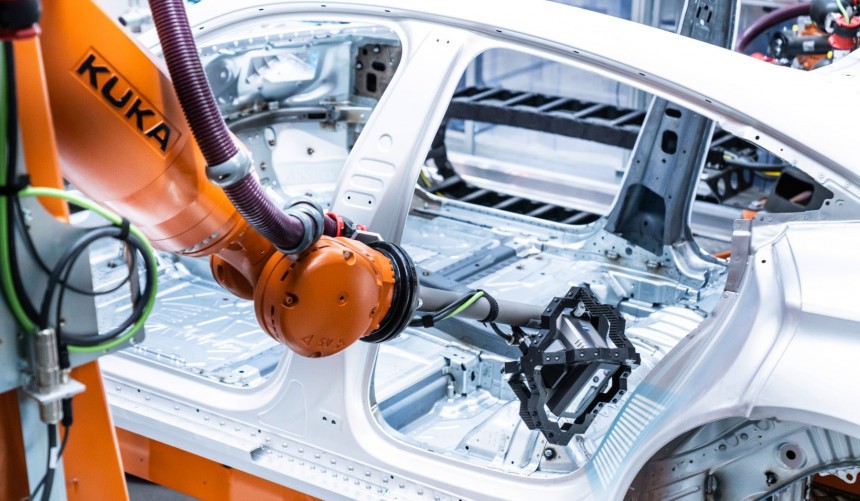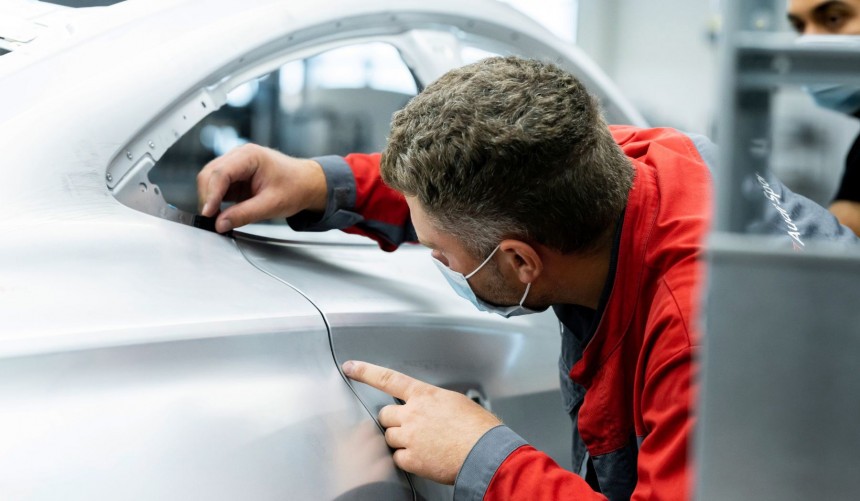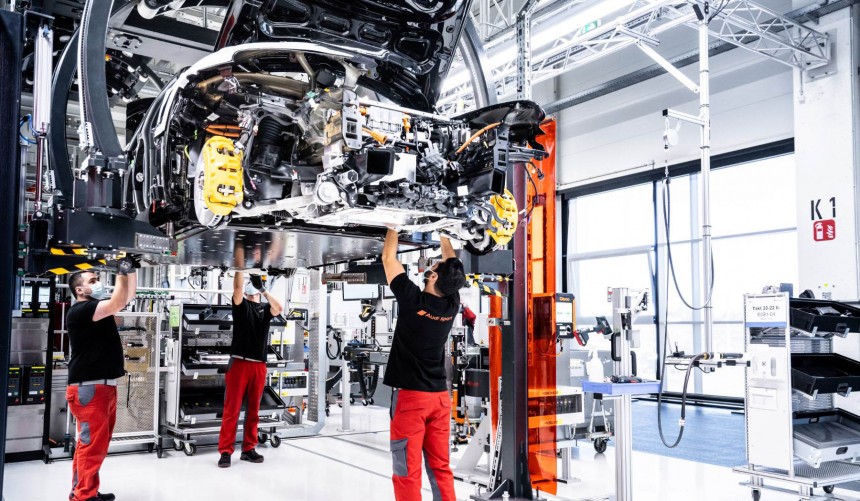The highly anticipated e-tron GT will be assembled at Audi Sport’s Bollinger Hofe plant sharing the production line with the R8. But manufacturing these two completely different models on the same line required the implementation of many innovative technologies.
Bringing together the best of both worlds required highly flexible planning, with the facility undergoing an upgrade and conversion as a result. Cutting-edge systems were installed in the assembly area and body shop, while brand-new logistics halls were constructed. They measure 10,000 square meters (107,639 sq ft) on the ground floor and an additional 800 square meters (8,611 sq ft) in the basement.
To achieve such a feat in record time, Audi developed its own VR software that enabled employees to map the interior space of the facility and use VR headsets and controllers to simulate all assembly and associated logistics procedures, a unique project in the Volkswagen Group.
The R8, which is based on the Audi Space Frame (ASF) technology, is almost exclusively assembled by hand, whereas the new all-electric GT is fabricated on an ultra-modern body assembly line that is 85% automated and features 34 robots that perform a total of nine “warm” and “cold” joining techniques.
The new car's body passes through 10 stations on the assembly line twice, to utilize the available space in the most efficient way possible.
The main station is a large clamping and attachment system called the two-way framer. During the first pass, this is where the inner side panels are joined together, with the outer panels attached during the second pass. The framer includes ten robots that use 32 high-tech tools to perform all nine joining techniques. Between the two passes, they automatically switch to the necessary tools.
Another innovative addition to the assembly line is the station where correlation-free measuring is performed. This is done at the end of the two passes using two robot-guided optical measuring heads that verify the exact dimensional accuracy of the body.
Furthermore, the body assembly line includes manual stations. Here, specialized personnel with many years of experience working on the R8 create precise weld connections.
After all these steps are performed, the e-tron GT’s body enters the so-called mounting stage, where skilled body manufacturers mount the aluminum hood, doors, and fenders, meticulously verifying every square inch of the panels.
The next step takes the body to the finishing area, where it undergoes another diligent investigation at the hands (and eagle eyes) of production and quality assurance experts.
Painting is done at the nearby Neckarsulm plant, after which the bodies of the e-tron GT are brought back to Bollinger Hofe and briefly stored along those of the R8 in the basement of the facility.
Autonomous transport vehicles bring them to the joint assembly line on the ground floor, orienting themselves using a digital map of the plant. There are 20 such vehicles that travel a combined distance of around 23 kilometers (14.3 mi) daily.
The Audi R8 and e-tron GT pass down the same line, being precisely coordinated. The same applies to the parts supply where logistics experts manage the two chains in such a way that all necessary parts arrive at the right moment in the corresponding assembly cycle.
The GT goes through 36 cycles, with each lasting no more than 15 minutes. During the first of these, employees install the interior. This is followed by the ‘marriage’ of the assembled bodies with the battery pack, suspension, and electric motors.
The assembly line's final stations are dedicated to the commissioning processes where the car is driven over dynos and calibration stands for suspension, lightning, braking, and assist systems.
The fully functional Audi e-tron GT can now exit the building and complete its first drive. After clearing the test and vibration track within the plant’s premises, it is driven on public roads for a journey of around 40 kilometers (24.9 mi) to test that everything performs as expected.
It then comes back to the facility for an 8-minute leak test in the rain chamber, which simulates heavy monsoon rainfall. This is followed by a comprehensive final check in two consecutive light tunnels where joints, gaps, and paintwork are comprehensively verified by Audi’s best quality assurance specialists.
Audi’s flagship EV is set to go on sale in the first part of 2021 with an estimated price tag of around $75,000. It will go head-to-head with the likes of Tesla’s Model S and its VW Group sibling, the gorgeous Porsche Taycan.
To achieve such a feat in record time, Audi developed its own VR software that enabled employees to map the interior space of the facility and use VR headsets and controllers to simulate all assembly and associated logistics procedures, a unique project in the Volkswagen Group.
The R8, which is based on the Audi Space Frame (ASF) technology, is almost exclusively assembled by hand, whereas the new all-electric GT is fabricated on an ultra-modern body assembly line that is 85% automated and features 34 robots that perform a total of nine “warm” and “cold” joining techniques.
The main station is a large clamping and attachment system called the two-way framer. During the first pass, this is where the inner side panels are joined together, with the outer panels attached during the second pass. The framer includes ten robots that use 32 high-tech tools to perform all nine joining techniques. Between the two passes, they automatically switch to the necessary tools.
Another innovative addition to the assembly line is the station where correlation-free measuring is performed. This is done at the end of the two passes using two robot-guided optical measuring heads that verify the exact dimensional accuracy of the body.
Furthermore, the body assembly line includes manual stations. Here, specialized personnel with many years of experience working on the R8 create precise weld connections.
After all these steps are performed, the e-tron GT’s body enters the so-called mounting stage, where skilled body manufacturers mount the aluminum hood, doors, and fenders, meticulously verifying every square inch of the panels.
Painting is done at the nearby Neckarsulm plant, after which the bodies of the e-tron GT are brought back to Bollinger Hofe and briefly stored along those of the R8 in the basement of the facility.
Autonomous transport vehicles bring them to the joint assembly line on the ground floor, orienting themselves using a digital map of the plant. There are 20 such vehicles that travel a combined distance of around 23 kilometers (14.3 mi) daily.
The Audi R8 and e-tron GT pass down the same line, being precisely coordinated. The same applies to the parts supply where logistics experts manage the two chains in such a way that all necessary parts arrive at the right moment in the corresponding assembly cycle.
The GT goes through 36 cycles, with each lasting no more than 15 minutes. During the first of these, employees install the interior. This is followed by the ‘marriage’ of the assembled bodies with the battery pack, suspension, and electric motors.
The fully functional Audi e-tron GT can now exit the building and complete its first drive. After clearing the test and vibration track within the plant’s premises, it is driven on public roads for a journey of around 40 kilometers (24.9 mi) to test that everything performs as expected.
It then comes back to the facility for an 8-minute leak test in the rain chamber, which simulates heavy monsoon rainfall. This is followed by a comprehensive final check in two consecutive light tunnels where joints, gaps, and paintwork are comprehensively verified by Audi’s best quality assurance specialists.
Audi’s flagship EV is set to go on sale in the first part of 2021 with an estimated price tag of around $75,000. It will go head-to-head with the likes of Tesla’s Model S and its VW Group sibling, the gorgeous Porsche Taycan.















